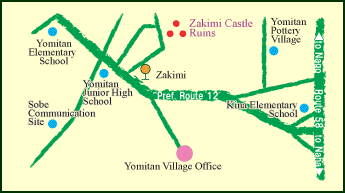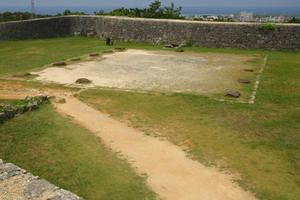Zakimi Castle
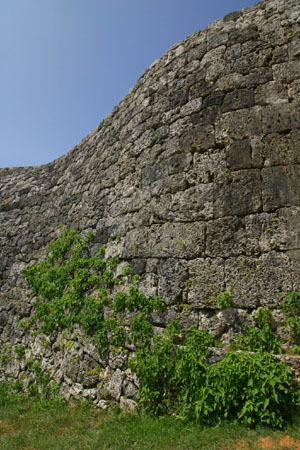
The ruins of Zakimi Castle are located in the central district of Okinawa Island, in Yomitan Village, close to the western seacoast. While the vast majority of Gusuku are built on Ryukyuan limestone hills that spread out in the central part of the island, one of the differing points of the Zakimi Castle ruins is that they are built on red earth named "Kunigami Ma-ji."
The Gusuku stands at an elevation of about 125 meters, offering a whole view from the Onnadake hills in the north to Motobu peninsula. To the west, the Kerama Islands can be seen floating in the East China Sea, and to the south, the entire central region. It has the perfect conditions necessary to be the location of a castle.
The ruins of Zakimi Castle are enclosed in two stone walls of differing heights. After entering through the first arched gate out front, a walled enclosure spreads out. In the depths is another arched gate and yet another higher wall widens out.
The castle walls zigzag like a Japanese folding screen and offer an exceptional view still today. The reason given as to why it stands today is related to the quality of the earth, as it supports a structure resistant to collapse. One of the advantages of the castle walls is that when this Gusuku became a battlefield, the top of the undulating walls could be used to attack the enemy trying to gain access. In the same way, from inside the second stone wall enclosure, if entering from the front on the left hand side there is a pathway that appears to lead to the depths of the Gusuku, but it actually takes one to a dead end. Of course it can be understood that the structure was constructed to add to the attack on the enemy from above the battle.
The walls are constructed from cut Ryukyuan limestone using both coursed "Nunodzumi" and fitted '"Akatadzumi" masonry techniques. The highest point of the walls is around 13 meters and the lowest point about 3 meters in height. The arched gates built into each of the outer and inner walls are estimated to be the oldest in the Ryukyus.
 It is believed that the Yuntanza Aji, Lord Gosamaru, built Zakimi Castle at the beginning of the 15th century and it was named Yuntanza Gusuku at the time. Before Zakimi Castle, Lord Gosamaru resided in Yamada Gusuku, located five kilometers to the northeast. Since the time of the Aji Haniji, the location of the Gusuku was to keep a sharp lookout on the Hokuzan Kingdom that attempted to build its might to rival the Chuzan Kingdom. However, in 1416 Gosamaru joined the forces fighting Hokuzan, which resulted in the subjugation of the Hokuzan Aji, Hananchi. After that, until 1422, Gosamaru assumed the duties of Hokuzan supervisor and lived in Nakijin Castle. Additionally, the history of Gosamaru's ancestral clan shows they were originally the lords of Nakijin Castle and were forced out with the rise of Haniji. Perhaps the retaking of Nakijin Castle fulfilled a long-cherished wish of Gosamaru to regain the land of his ancestors. Gosamaru subsequently built Zakimi Castle and moved there. To confront a renewed threat from an old enemy, Amawari of Katsuren, the Chuzan king ordered Gosamaru to move to Nakagusuku Castle from Zakimi Castle with its good harbor and enormous territory.
It is believed that the Yuntanza Aji, Lord Gosamaru, built Zakimi Castle at the beginning of the 15th century and it was named Yuntanza Gusuku at the time. Before Zakimi Castle, Lord Gosamaru resided in Yamada Gusuku, located five kilometers to the northeast. Since the time of the Aji Haniji, the location of the Gusuku was to keep a sharp lookout on the Hokuzan Kingdom that attempted to build its might to rival the Chuzan Kingdom. However, in 1416 Gosamaru joined the forces fighting Hokuzan, which resulted in the subjugation of the Hokuzan Aji, Hananchi. After that, until 1422, Gosamaru assumed the duties of Hokuzan supervisor and lived in Nakijin Castle. Additionally, the history of Gosamaru's ancestral clan shows they were originally the lords of Nakijin Castle and were forced out with the rise of Haniji. Perhaps the retaking of Nakijin Castle fulfilled a long-cherished wish of Gosamaru to regain the land of his ancestors. Gosamaru subsequently built Zakimi Castle and moved there. To confront a renewed threat from an old enemy, Amawari of Katsuren, the Chuzan king ordered Gosamaru to move to Nakagusuku Castle from Zakimi Castle with its good harbor and enormous territory.

After his move to Nakagusuku Castle, there is no confirmed historical documentation dealing with the positions of the other Aji chieftains toward Gosamaru. However, when Amawari attacked Nakagusuku Castle it is said the Yutanza Aji tended to support Gosamaru, commander of the troops. In another age, in the midst of the Battle of Okinawa, an anti-aircraft emplacement was constructed there to take advantage of its elevated position. It was also utilized as part of a U.S. military base after the war.
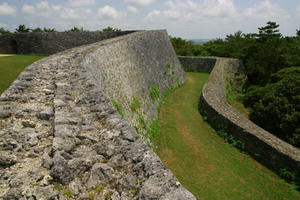 Gosamaru, who built Zakimi Castle, was considered an outstanding castle architect. The actual work gathered together many workers, from those involved in stone quarrying to transportation. Stones from Yamada Gusuku were transported by hand and used. The workers were assigned an area and used relays to ferry the stones to where tasks were allotted for masonry work.
Gosamaru, who built Zakimi Castle, was considered an outstanding castle architect. The actual work gathered together many workers, from those involved in stone quarrying to transportation. Stones from Yamada Gusuku were transported by hand and used. The workers were assigned an area and used relays to ferry the stones to where tasks were allotted for masonry work.
The workers were not only from the Yutanza vicinity. Laborers were requisitioned from Kikai Island, Amami-Daito Island, Yoron Island, Okierabu Island, and the Kerama Islands as well.
Because of his prestige after the defeat of Hokuzan, Gosamaru's ruling power increased and on these islands it is related that people would say "Gosamaru is coming!" to crying children to make them quiet down. Perhaps it is the result of his gathering a labor force through authority and compulsion.
(Nakagami-gun, Yomitan Village), Designated Historical
Site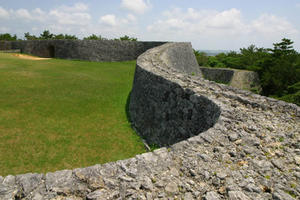 This castle was built by powerful Aji (regional chieftain) Gosamaru in 1420. After the downfall of the Hokuzan Kingdom, the castle was constructed to keep a watch over the area. It was vital in stabilizing the region in the early period of the Ryukyu Kingdom's establishment. It is a designated historic sight.
This castle was built by powerful Aji (regional chieftain) Gosamaru in 1420. After the downfall of the Hokuzan Kingdom, the castle was constructed to keep a watch over the area. It was vital in stabilizing the region in the early period of the Ryukyu Kingdom's establishment. It is a designated historic sight.
Management / Inquiries
Yomitan Village Board of Education Culture Promotion Section
708-6 Zakimi, Yomitan Village, Okinawa 904-0301 Japan
Phone: (098)958-3141
[USE GUIDE]
Viewing is Free of Charge
[Map]
